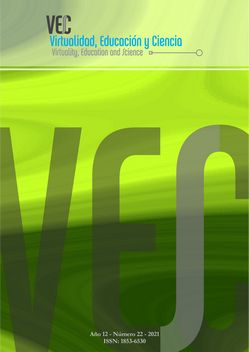Changes in the teaching and learning modality within the framework of an institutional model. The case of the Methodology of Economics class
DOI:
https://doi.org/10.60020/1853-6530.v12.n22.32120Keywords:
blended learning, agency-structure institutional model, economic sciences, educational technologyAbstract
The purpose of this article is to examine the transition from a face-to-face learning modality to a blended learning modality experienced by a course on Methodology of Economics, at the Faculty of Economic Sciences, National University of Córdoba. An institutional model is used as a theoretical framework; such model explains the existing interrelation between standards that regulate the teaching and learning processes on the one hand, and the students and instructors’ practices on the other hand. A quantitative analysis shows that the blended learning option yields better results in terms of student performance. This is explained by various qualitative factors, such as emphasis on skills acquisition, continuous and individualized support to students, and an emphasis on the development of scientific writing abilities. In addition, this article shows how the change in the learning modality affects the structure of rights, tasks, duties, and privileges of the actors involved in the learning process.
Downloads
References
ABDELNOUR, S., HASSELBLADH, H., y KALLINIKOS, J. (2017). Agency and institutions in organization studies. Organization Studies, 38(2), 1775–1792.
AL-BAHRANIA, A. y PATEL, D. (2015). Incorporating Twitter, Instagram, and Facebook in Economics classrooms. The Journal of Economic Education, 46(1), 56–67.
BARTLETT, R. (2006). The evolution of cooperative learning and Economics instruction. En Becker, W.E., M. Watts y S.R. Becker (eds.), Teaching Economics: More Alternatives to Chalk and Talk. Cheltenham, UK: Edward Elgar: 39–58.
BRAVINO, L. y MAGARIA, O. (2018). El aula de Matemática Financiera a distancia. En Magaria, O. y G. Sabulsky (comps.), I Jornadas de Aulas Abiertas. Córdoba, Argentina: Universidad Nacional de Córdoba, 92–98.
HODGSON, G.M. (2004). The Evolution of Institutional Economics. London, UK: Routlegde.
HODGSON, G.M. (2006). What are institutions? Journal of Economic Issues, 40(1), 1–25.
JUÁREZ JEREZ, H., FORESTELLO, R. y PERONA, E. (2009). El proceso de enseñanza en el área de las ciencias económicas. ¿Qué contenidos se enseñan y cómo se enseñan? En VI Encuentro Nacional y III Latinoamericano La Universidad como Objeto de Investigación. Córdoba, Argentina, 12-14 de noviembre.
JUÁREZ JEREZ, H., PERONA, E., FORESTELLO, R., QUADRO, M. y NAVARRETE, J. (2010). El proceso de enseñanza en el área de las ciencias económicas. Informe Final Proyecto SeCyT, FCE-UNC. Córdoba, Argentina: Universidad Nacional de Córdoba.
KASSENS, A. (2014). Tweeting your way to improved #Writing, #Reflection, and #Community. The Journal of Economic Education, 45(2), 101–109.
KEENAN, D. y MAIER, M. (2004). Economics Live! Learning Economics the Collaborative Way, 4a Ed. Boston, MA, EE.UU.: McGraw-Hill.
LAWSON, T. (2003). Reorienting Economics. London, UK: Routledge.
MAGARIA, O. (2019). El resumen de la tutoría elaborado y compartido por los estudiantes. En Kap, M., O. Magaria, V, Mertens y G. Sabulsky (eds.), Prácticas y Relatos sobre la Enseñanza. Mar del Plata, Argentina: Universidad Nacional de Mar del Plata, 171–176.
OSTROM, E. (2005). Understanding Institutional Diversity. Princeton, NJ, EE.UU.: Princeton University Press.
OSTROM, E. (2007). Institutional rational choice: An assessment of the institutional analysis and development framework. En Sabatier, P.A. (ed.), Theories of the Policy Process. Boulder, CO, EE.UU.: Westview Press, 21–64.
OSTROM, E. y BASURTO, X. (2011). Crafting analytical tools to study institutional change. Journal of Institutional Economics, 7(3), 317–343.
PERONA, E. y CUTTICA, M. (2018). Enseñanza de la economía: el desafío de las nuevas tecnologías. En Magaria, O. y G. Sabulsky (comps.), I Jornadas de Aulas Abiertas. Córdoba, Argentina: Universidad Nacional de Córdoba, 114–118.
PERONA, E. y CUTTICA, M. (2019). Acompañamiento en el desarrollo de habilidades de redacción en la materia Metodología de la Economía. En Kap, M., O. Magaria, V, Mertens y G. Sabulsky (eds.), Prácticas y Relatos sobre la Enseñanza. Mar del Plata, Argentina: Universidad Nacional de Mar del Plata, 111–116.
RAVEAUD, G. (2009). Pluralism in economics teaching–Why and how? Development Dialogue, 2, 43–77.
SUÁREZ LANTARÓN, B. (2018). WhatsApp: uso educativo, ventajas y desventajas. Revista de Investigación en Educación, 16(2), 121–135.
WILLIAMS, W. y WALKER, J. (2014). Computerized laboratory exercises for Microeconomics education: Three applications motivated by Experimental Economics. The Journal of Economic Education, 24(4), 291–315.
Published
How to Cite
Issue
Section
License
Copyright (c) 2021 Eugenia Perona , Mariela Cuttica

This work is licensed under a Creative Commons Attribution-NonCommercial 4.0 International License.
The generation of derivative works is allowed as long as it is not done for commercial purposes. The original work may not be used for commercial purposes.


